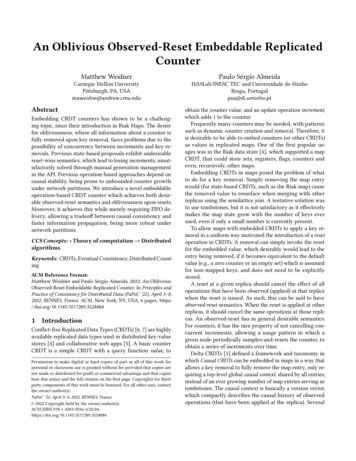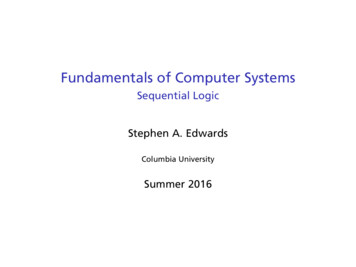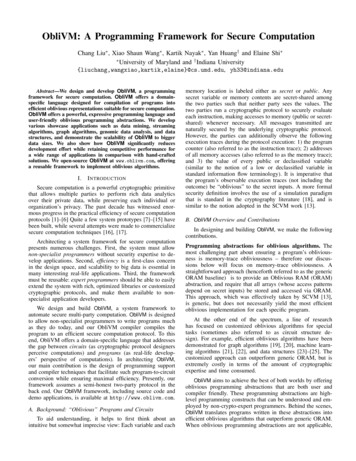
Transcription
An Oblivious Observed-Reset Embeddable ReplicatedCounterMatthew WeidnerPaulo Sérgio AlmeidaCarnegie Mellon UniversityPittsburgh, PA, USAmaweidne@andrew.cmu.eduHASLab/INESC TEC and Universidade do MinhoBraga, Portugalpsa@di.uminho.ptAbstractEmbedding CRDT counters has shown to be a challenging topic, since their introduction in Riak Maps. The desirefor obliviousness, where all information about a counter isfully removed upon key removal, faces problems due to thepossibility of concurrency between increments and key removals. Previous state-based proposals exhibit undesirablereset-wins semantics, which lead to losing increments, unsatisfactorily solved through manual generation managementin the API. Previous operation-based approaches depend oncausal stability, being prone to unbounded counter growthunder network partitions. We introduce a novel embeddableoperation-based CRDT counter which achieves both desirable observed-reset semantics and obliviousness upon resets.Moreover, it achieves this while merely requiring FIFO delivery, allowing a tradeoff between causal consistency andfaster information propagation, being more robust undernetwork partitions.CCS Concepts: Theory of computation Distributedalgorithms.Keywords: CRDTs, Eventual Consistency, Distributed CountingACM Reference Format:Matthew Weidner and Paulo Sérgio Almeida. 2022. An ObliviousObserved-Reset Embeddable Replicated Counter. In Principles andPractice of Consistency for Distributed Data (PaPoC ’22), April 5–8,2022, RENNES, France. ACM, New York, NY, USA, 6 pages. onConflict-free Replicated Data Types (CRDTs) [6, 7] are highlyavailable replicated data types used in distributed key-valuestores [4] and collaborative web apps [5]. A basic counterCRDT is a simple CRDT with a query function value, toPermission to make digital or hard copies of part or all of this work forpersonal or classroom use is granted without fee provided that copies arenot made or distributed for profit or commercial advantage and that copiesbear this notice and the full citation on the first page. Copyrights for thirdparty components of this work must be honored. For all other uses, contactthe owner/author(s).PaPoC ’22, April 5–8, 2022, RENNES, France 2022 Copyright held by the owner/author(s).ACM ISBN 17209.3524084obtain the counter value, and an update operation increment,which adds 1 to the counter.Frequently many counters may be needed, with patternssuch as dynamic counter creation and removal. Therefore, itis desirable to be able to embed counters (or other CRDTs)as values in replicated maps. One of the first popular usages was in the Riak data store [4], which supported a mapCRDT, that could store sets, registers, flags, counters andeven, recursively, other maps.Embedding CRDTs in maps posed the problem of whatto do for a key removal. Simply removing the map entrywould (for state-based CRDTs, such as the Riak map) causethe removed value to resurface when merging with otherreplicas using the semilattice join. A tentative solution wasto use tombstones, but it is not satisfactory as it effectivelymakes the map state grow with the number of keys everused, even if only a small number is currently present.To allow maps with embedded CRDTs to apply a key removal in a uniform way motivated the introduction of a resetoperation in CRDTs. A removal can simply invoke the resetfor the embedded value, which desirably would lead to theentry being removed, if it becomes equivalent to the defaultvalue (e.g., a zero counter or an empty set) which is assumedfor non-mapped keys, and does not need to be explicitlystored.A reset at a given replica should cancel the effect of alloperations that have been observed (applied) at that replicawhen the reset is issued. As such, this can be said to haveobserved-reset semantics. When the reset is applied at otherreplicas, it should cancel the same operations at those replicas. An observed-reset has in general desirable semantics.For counters, it has the nice property of not cancelling concurrent increments, allowing a usage pattern in which agiven node periodically samples-and-resets the counter, toobtain a series of increments over time.Delta CRDTs [1] defined a framework and taxonomy inwhich Causal CRDTs can be embedded in maps in a way thatallows a key removal to fully remove the map entry, only requiring a top-level global causal context, shared by all entries,instead of an ever growing number of map entries serving astombstones. The causal context is basically a version vector,which compactly describes the causal history of observedoperations (that have been applied at the replica). Several
PaPoC ’22, April 5–8, 2022, RENNES, FranceCRDTs such as flags, registers, sets, or maps themselves canbe described as causal CRDTs.For state-based CRDTs, the problem with embbeding counters is that, contrary to most CRDTs, that can afford to assign a dot (unique event identifier as a pair replica-id andsequence number) per operation, for counters we can havemillions of increments. Counter CRDTs cannot afford to tageach individual increment and as such are not causal CRDTs.One approach [2] to embedding makes counters be causalCRDTs by grouping increments in generations, but abandonsthe desirable observed-reset semantics, and allows a reset tocancel concurrent increments.For operation-based CRDTs, a solution to embedding counters was devised [8], but it relies on causal stability [3]. As itkeeps individual not-yet-causally-stable increments, it canlead to unacceptably large state growth, given a high increment rate, under network partitions.In this paper, we present a novel embeddable counterCRDT that simultaneously satisfies two desirable properties:1. observed-reset semantics: a reset cancels all increments that have been observed (applied) at the replicawhere the reset is issued;2. oblivious resets: a fully reset counter allows key removal from the map where it is embedded, i.e., allowsdiscarding all per-counter metadata.The state size is bounded by the number of replicas, independent of the number of increments. More specifically,each counter’s state size is proportional to the number ofreplicas that have sent outstanding increments—either notyet reset, or reset but not yet received. The only other storagespace required is a single global version vector, containingone entry per replica, that can be shared by all counters in amap (or recursively, by all counters embedded in all maps . . .embedded in a map).The novel design is an op-based CRDT which draws ingredients from both op-based and state-based designs: Although op-based, the CRDT state is based on statebased designs, notably causal CRDTs, with per-nodeentries both in per-key metadata and the global causalcontext. It draws inspiration from grouping increments in generations, but contrary to the previous design [2], notonly it does not require any manual generation management in the API, but it also ensures observed-resetsemantics; one key difference from the previous design is that here the global version vector has a fineraccounting granularity, while in that design it hadgeneration granularity. It exploits the exactly-once delivery guarantee (presentin the causal delivery mechanisms used in op-baseddesigns) but it does not need causal delivery, requiringonly the much simpler and cheaper FIFO order.Matthew Weidner and Paulo Sérgio AlmeidaNot requiring causal delivery has the advantage of providing faster increment and reset propagation, and makesthe algorithm more robust to network partitions. While forcomplex data types causal consistency is the norm of whatto aim for in highly available systems, for counting it maynot always be needed, and it may be beneficial to be able totradeoff between freshness and causal consistency.Depending only on FIFO order posed subtle problems, thatwere solved in the novel design, such as a reset arriving ata replica where some of its cancelled increments have notyet been delivered, while allowing oblivousness when thepending increments arrive later, if possible.2Observed-Reset CountersFor state-based CRDTs or op-based CRDTs when causal delivery is used, defining the acceptable semantics for whatis an observed-reset CRDT is simple: a reset cancels theincrements from the causal past.However, for op-based CRDTs aiming for more generaldesigns with less messaging requirements, namely not requiring causal delivery, gaining freshness but forgoing causalconsistency, defining acceptable semantics requires somecare.In general, knowledge about both increments and resetsissued can travel independently, carried by either resets orincrements that are delivered. Given the incremental natureof op-based designs, full transitive knowledge propagation isunrealistic, specially when increments are delivered, but forresets (assuming that they are a more rarely issued operation)more knowledge propagation is realistic.Regardless of slower or faster propagation, any given algorithm step will have to respect constraints, according towhat the algorithm did in the past, that led to the currentreplica state. To define acceptable semantics, first we definetwo sets, as a function of the set of operations 𝑆 applied atthe replica (i.e., its state): increments(𝑆): the increments propagated by 𝑆; cancelled(𝑆): the cancellations propagated by 𝑆.The increments that are being observed, i.e., that reachedthe replica and were not yet cancelled, is the observed set:observed(𝑆) increments(𝑆) \ cancelled(𝑆),and the counter value is just the size of this set:value(𝑆) observed(𝑆) .When a reset is issued it must cancel this set, no lessand no more. However, both increments and resets, whendelivered (applied) to a replica, may propagate informationabout both increments(𝑆) and cancelled(𝑆) for state 𝑆 wherethe operation is issued.We define cancels(𝑂) as the set of cancellations that arepropagated by an operation 𝑂, to be joined to the cancelled
An Oblivious Observed-Reset Embeddable Replicated Counterincrements when delivered to replica state 𝑆:PaPoC ’22, April 5–8, 2022, RENNES, France1cancelled(𝑆 {𝑂 }) cancelled(𝑆) cancels(𝑂).2The possible boundaries, given an operation issued atreplica state 𝑆, for an increment operation 𝐼 :345 cancels(𝐼 ) cancelled(𝑆),6i.e., an increment does not need to propagate cancellationsat all, but may propagate all known cancellations. For a resetoperation 𝑅:observed(𝑆) cancels(𝑅) increments(𝑆),i.e., a reset needs to cancel at least the observed set, resultingin a zero counter when it is applied at the origin, but maypropagate more information to other replicas, limited to thelocally known increments. This prevents resetting not yetknow increments, avoiding increment loss.Similarly, we define adds(𝑂) as the set of increments thatare propagated by an operation 𝑂, to be joined to increments(𝑆)when delivered to replica state 𝑆:increments(𝑆 {𝑂 }) increments(𝑆) adds(𝑂).The possible boundaries, given an operation issued atreplica state 𝑆, for an increment operation 𝐼 :7811update inc()12131415161718192021i.e., an increment needs to propagate itself, but may propagate all known increments. For a reset operation 𝑅:23adds(𝑅) cancels(𝑅).24252627282930313233343DesignOur counter is an operation-based CRDT [7]. Each operationhas a generator and an effector. The generator is called by theacting replica and returns a message to be broadcast to theother replicas. Each replica, including the sender, applies theoperation by inputting this message to the correspondingeffector.We assume that operations are applied exactly once. Wealso assume FIFO order: for each replica 𝑗, all other replicasapply operations from 𝑗 in the order they were sent, acrossall counter instances sharing the same global version vector.We do not require causal delivery.Algorithm 1 gives the complete counter CRDT. We use𝑖 to denote the local replica, so in the generators, 𝑖 is thesender, while in the effectors, 𝑖 is the receiver and 𝑗 is theper-instance CRDT state:𝑀 : I (p : N, n : N, c : N)// assuming 𝑀 [ 𝑗] (0, 0, 0) for unmapped keysquery value() : NÍreturn {𝑝 𝑛 ( 𝑗, (𝑝, 𝑛, 𝑐)) 𝑀 }922i.e., a reset may propagate from nothing up to the full set ofknown increments.As a further constraint, a reset does not need to propagateincrements at all, but if it chooses to do so, given that allthose increments were already or are being cancelled at theorigin, it should propagate at least those also as cancellations,i.e., the constraint:global replica state:𝐶:I N// assuming 𝐶 [ 𝑗] 0 for unmapped keys10{𝐼 } adds(𝐼 ) increments(𝑆) {𝐼 }, adds(𝑅) increments(𝑆),types:I, set of replica identifiers35363738generator ()if 𝑖 dom(𝑀) thenreturn (inc, 𝑖, 𝐶 [𝑖] 1, true)elsereturn (inc, 𝑖, 𝑀 [𝑖].p 1, false)effector (inc, 𝑗, 𝑝, 𝑠𝑡𝑎𝑟𝑡)let 𝑐 𝐶 [ 𝑗] 1if 𝑠𝑡𝑎𝑟𝑡 𝑗 dom(𝑀) then𝑀 [ 𝑗] max(𝑀 [ 𝑗], (𝑝, 𝑝 1, 𝑐))// max is taken entry-wiseelse𝑀 [ 𝑗] max(𝑀 [ 𝑗], (𝑝, 0, 𝑐))if 𝑀 [ 𝑗].p 𝑀 [ 𝑗].n 𝑀 [ 𝑗].c 𝑐 then𝑀. remove( 𝑗)𝐶 [ 𝑗] 𝑐update reset()generator ()return (reset, {( 𝑗, 𝑝, 𝑐) ( 𝑗, (𝑝, 𝑛, 𝑐)) 𝑀 })effector (reset, 𝑅)for ( 𝑗, 𝑝, 𝑐) in 𝑅 doif 𝑗 dom(𝑀) thenif 𝑐 𝐶 [ 𝑗] then𝑀 [ 𝑗] (𝑝, 𝑝, 𝑐)else𝑀 [ 𝑗] max(𝑀 [ 𝑗], (𝑝, 𝑝, 𝑐))if 𝑀 [ 𝑗].p 𝑀 [ 𝑗].n 𝑀 [ 𝑗].c 𝐶 [ 𝑗] then𝑀. remove( 𝑗)Algorithm 1: Counter algorithm for replica 𝑖.sender. Each CRDT and replica has its own map 𝑀, whilethe map 𝐶 is shared by all CRDTs on a given replica.Algorithm 1 is a modification of the delta state-based PNcounter CRDT [1], as we now explain in four steps.1. Start with Delta State-Based PN-Counter. The stateof a delta state-based PN-counter CRDT is a partial map𝑀 : I (𝑝, 𝑛), where I is the set of replica identifiersand the values 𝑝, 𝑛 are nonnegative integers. Its value is
PaPoC ’22, April 5–8, 2022, RENNES, FranceÍ{𝑝 𝑛 ( 𝑗, (𝑝, 𝑛)) 𝑀 }. To increment the counter, replica𝑖 broadcasts 𝑀 [𝑖].𝑝 1; each replica then takes the max ofthis with its own 𝑀 [𝑖].𝑝 entry. Ordinarily, the 𝑛 entries areused in an analogous way for decrements, but we can insteaduse them for resets: to reset the counter, replica 𝑖 broadcasts{( 𝑗, 𝑝) ( 𝑗, (𝑝, 𝑛)) 𝑀 }; then for each ( 𝑗, 𝑝), each replicasets 𝑀 [ 𝑗].𝑛 max(𝑀 [ 𝑗].𝑛, 𝑝).This modified PN-counter implements the observed-resetsemantics and has a small state. However, once such a counteris used, its state is always nontrivial: even when reset, itstores the largest 𝑝 value sent out by each replica. Thus it isnot oblivious.2. Delete Fully-Reset Entries. To fix the issue, we candelete any entries 𝑀 [ 𝑗] such that 𝑀 [ 𝑗].𝑝 𝑀 [ 𝑗].𝑛. Thisdoes not affect the counter’s value, and it means that fullyreset counters have empty 𝑀. Hence fully-reset counters in amap can be stored without any per-key metadata. However,the resulting design is broken: it has the wrong semantics,and it is not even a CRDT.3. Fix Semantic Problems. The first problem comes whenreplica 𝑗 sends an increment 𝑝 concurrently to a reset. Areplica that receives the reset first will delete 𝑀 [ 𝑗]. Thenafter receiving the increment, it will set 𝑀 [ 𝑗] (𝑝, 0). Butthe correct entry—what it would have been in the originalPN-counter—is 𝑀 [ 𝑗] (𝑝, 𝑛), where 𝑛 is whatever 𝑀 [ 𝑗].𝑛was before deletion.To fix this, we observe: assuming FIFO order, the old valueof 𝑛 must be 𝑝 1. Indeed, the new increment 𝑝 is the firstincrement sent by 𝑗 that is not cancelled by the reset. Thusthe reset must have cancelled all of 𝑗’s prior increments,which went up to 𝑝 1. By this observation, when a replicareceives the increment 𝑝, it should set 𝑀 [ 𝑗] (𝑝, 𝑝 1)instead of 𝑀 [ 𝑗] (𝑝, 0) (line 20).The second problem comes when replica 𝑗 wants to sendan increment just after receiving a reset. It is supposed tosend 𝑝 1, where 𝑝 is whatever 𝑀 [ 𝑗].𝑝 was before the reset,but 𝑀 [ 𝑗] may have been deleted. However, the PN-counterstill works if 𝑗 sends a value 𝑝 ′ 𝑝 1, so long as they alsoinstruct recipients to set 𝑀 [ 𝑗].𝑛 𝑝 ′ 1 (using a 𝑠𝑡𝑎𝑟𝑡 flagto signal whether a new generation of consecutive 𝑝 valuesis starting). One such value is 𝑝 ′ 𝐶 [ 𝑗] 1, where 𝐶 [ 𝑗] is aglobal value, shared by all CRDT instances, that counts thetotal number of increments issued by replica 𝑗.4. Extend to FIFO Order. Finally, we need to handle noncausally-ordered delivery. Specifically, the algorithm breaksif we receive a reset, delete 𝑀 [ 𝑗] because of it, then receive acausally prior increment sent by 𝑗. We fix this by waiting todelete 𝑀 [ 𝑗] until after we have received all such increments.Algorithm 1 tracks that condition using a third entry, 𝑐, in𝑀 [ 𝑗] (𝑝, 𝑛, 𝑐). That entry tells us to wait to delete 𝑀 [ 𝑗]until we have received the first 𝑐 increments from 𝑗 (acrossall CRDT instances). In order to track this condition, eachMatthew Weidner and Paulo Sérgio Almeidareplica 𝑖 stores not just its own 𝐶 entry 𝐶 [𝑖], but also anentry 𝐶 [ 𝑗] for each replica 𝑗, counting the total number ofincrements received from replica 𝑗.4CorrectnessTheorem 4.1. Algorithm 1 is an observed-reset counter. Thatis, there are functions cancels(𝑂) and adds(𝑂), satisfyingthe constraints in Section 2, such that in any execution ofAlgorithm 1 with FIFO order, a replica that has applied the setof operations 𝑆 has value value(𝑆).In particular, the algorithm exhibits strong eventual consistency: two replicas that have applied the same sets ofoperations have the same value.We prove Theorem 4.1 indirectly using Algorithm 2. Algorithm 2 is like Algorithm 1, except it does not delete fullyreset entries. This makes it easier to analyze. We will provethat the two algorithms are equivalent, then prove that Algorithm 2 is an observed-reset counter, from which Theorem 4.1follows.The specific changes in Algorithm 2 relative to Algorithm 1 are: 𝐶 and 𝑀 are renamed to 𝐶 ′ and 𝑀 ′, for clarity in thediscussion below. The lines 𝑀. remove( 𝑗) and their if statements areremoved (lines 24–25 and 37–38). The condition if 𝑖 dom(𝑀) (line 13) is replaced withif 𝑖 dom(𝑀 ′) 𝑀 ′ [𝑖].p 𝑀 ′ [𝑖].n. The condition if 𝑠𝑡𝑎𝑟𝑡 𝑗 dom(𝑀) on line 19 issimplified to if 𝑠𝑡𝑎𝑟𝑡. The reset generator (line 29) is changed toreturn (reset, {( 𝑗, 𝑝, 𝑐) ( 𝑗, (𝑝, 𝑛, 𝑐)) 𝑀 ′ (𝑝 𝑛 𝑐 𝐶 ′ [ 𝑗])}) In the reset effector, only the second case is present(line 36).Proposition 4.2. In any execution, a replica using Algorithm 2 will have the same behavior as the same replicausing Algorithm 1, i.e., it will output the same messages andreturn the same query values.Proof sketch. We claim that in any execution, using bothalgorithms side-by-side identically, the original state (𝐶, 𝑀)and the alternate state (𝐶 ′, 𝑀 ′) always satisfy the followingcorrespondence:𝐶 ′ 𝐶, and 𝑀 is the same as 𝑀 ′ except that 𝑀omits any entries 𝑗 such that 𝑀 ′ [ 𝑗].𝑝 𝑀 ′ [ 𝑗].𝑛and 𝑀 ′ [ 𝑗].𝑐 𝐶 ′ [ 𝑗].Using this correspondence claim, one can check that inevery case, the two algorithms output the same messagesand return the same query values.To prove the correspondence claim, we need to show thatif it is true before effecting a message 𝑚, then it is also trueafterwards.
An Oblivious Observed-Reset Embeddable Replicated Counter12345678global replica state:𝐶′ : I N// assuming 𝐶 ′ [ 𝑗] 0 for unmapped keysper-instance CRDT state:𝑀 ′ : I (p : N, n : N, c : N)// assuming 𝑀 ′ [ 𝑗] (0, 0, 0) for unmapped keysquery value() : NÍreturn {𝑝 𝑛 ( 𝑗, (𝑝, 𝑛, 𝑐)) 𝑀 ′ }11update inc()1213141516171819202122232425262728293031– the value 𝑝 in the most recent increment message(inc, 𝑗, 𝑝, 𝑠𝑡𝑎𝑟𝑡) 𝑆, and– the maximum across all values 𝑝 such that ( 𝑗, 𝑝, 𝑐)appears in a reset message in 𝑆.(If there are no such messages, then 𝑀 ′ [ 𝑗] is not present.) For each 𝑗, 𝑀 ′ [ 𝑗].𝑛 is the maximum of:– the value 𝑝 1 corresponding to the most recentincrement message of the form (inc, 𝑗, 𝑝, true) 𝑆,and– the maximum across all values 𝑝 such that ( 𝑗, 𝑝, 𝑐)appears in a reset message in 𝑆.(If there are no such messages, then 𝑀 ′ [ 𝑗] is not present.)types:I, set of replica identifiers109PaPoC ’22, April 5–8, 2022, RENNES, Francegenerator ()if 𝑖 dom(𝑀 ′) 𝑀 ′ [𝑖].p 𝑀 ′ [𝑖].n thenreturn (inc, 𝑖, 𝐶 ′ [𝑖] 1, true)elsereturn (inc, 𝑖, 𝑀 ′ [𝑖].p 1, false)We can translate this point-by-point into definitions foradds(𝑂) and cancels(𝑂): adds:– For an increment operation 𝐼 , adds(𝐼 ) {𝐼 }.– For a reset operation 𝑅, adds(𝑅) is the set of increments 𝐼 (inc, 𝑗, 𝑝 ′, 𝑠𝑡𝑎𝑟𝑡) such that there exists( 𝑗, 𝑝, 𝑐) 𝑅 with 𝑝 ′ 𝑝. cancels:– For an increment operation 𝐼 (inc, 𝑗, 𝑝, 𝑠𝑡𝑎𝑟𝑡), if𝑠𝑡𝑎𝑟𝑡 true, then cancels(𝐼 ) is the set of prior increments sent by replica 𝑗; else cancels(𝐼 ) .– For a reset operation 𝑅, cancels(𝑅) is the same asadds(𝑅).effector (inc, 𝑗, 𝑝, 𝑠𝑡𝑎𝑟𝑡)let 𝑐 𝐶 ′ [ 𝑗] 1if 𝑠𝑡𝑎𝑟𝑡 then𝑀 ′ [ 𝑗] max(𝑀 ′ [ 𝑗], (𝑝, 𝑝 1, 𝑐))// max is taken entry-wiseelse𝑀 ′ [ 𝑗] max(𝑀 ′ [ 𝑗], (𝑝, 0, 𝑐))′𝐶 [ 𝑗] 𝑐With these definitions, the query valueÕ{𝑝 𝑛 ( 𝑗, (𝑝, 𝑛, 𝑐)) 𝑀 ′ }update reset()generator ()return (reset, {( 𝑗, 𝑝, 𝑐) ( 𝑗, (𝑝, 𝑛, 𝑐)) 𝑀 ′ (𝑝 𝑛 𝑐 𝐶 ′ [ 𝑗])})equals value(𝑆). Finally, one can check that adds(𝑂) andcancels(𝑂) satisfy the constraints in Section 2. effector (reset, 𝑅)for ( 𝑗, 𝑝, 𝑐) in 𝑅 do𝑀 ′ [ 𝑗] max(𝑀 ′ [ 𝑗], (𝑝, 𝑝, 𝑐))5Algorithm 2: Alternate algorithm for replica 𝑖, used inthe proof of Theorem 4.1.This is a case analysis. The only interesting case is when𝑚 (inc, 𝑗, 𝑝, false) is an increment that does not start anew generation, but Algorithm 1 does not have an entry𝑀 [ 𝑗]. That can only happen if we previously received aconcurrent reset that caused us to delete entry 𝑀 [ 𝑗]. Thuswe are in the setting of Step 3 in Section 3. From the argumentthere, it follows that Algorithm 2 ends the effector with𝑀 ′ [ 𝑗].𝑛 𝑝 1, just like in Algorithm 1. Proof sketch for Theorem 4.1. By Proposition 4.2, it sufficesto prove that Algorithm 2 is an observed-reset counter.It is easy to check that after applying the set of operations𝑆, the state of Algorithm 2 satisfies: For each 𝑗, 𝑀 ′ [ 𝑗].𝑝 is the maximum of:Efficiency5.1State SizeThe per-instance state for a counter using Algorithm 1 is justthe map 𝑀. Thus the per-instance state size is proportionalto the number of entries in 𝑀. There is also the global versionvector 𝐶, shared by all CRDT instances, which has one entryper replica.The number of entries in 𝑀 is always upper bounded bythe number of replicas. However, we can get a more preciseguarantee:Proposition 5.1. In any execution of Algorithm 1 with FIFOorder, a replica that has applied the set of operations 𝑆 hasan entry 𝑀 [ 𝑗] for replica 𝑗 if and only if either:(a) observed(𝑆) contains an increment sent by 𝑗, i.e., 𝑗 hassent a not-yet-reset increment; or(b) there is an increment 𝐼 sent by 𝑗 such that𝐼 cancelled(𝑆) \ 𝑆,i.e., the increment has been cancelled but not yet received, due to a reset applied out-of-order.
PaPoC ’22, April 5–8, 2022, RENNES, FranceProof sketch. By the correspondence in the proof of Proposition 4.2, 𝑀 [ 𝑗] exists if and only if in the correspondingexecution of Algorithm 2, 𝑀 ′ [ 𝑗] exists and either 𝑀 ′ [ 𝑗].𝑝 𝑀 ′ [ 𝑗].𝑛 or 𝑀 ′ [ 𝑗].𝑐 𝐶 [ 𝑗]. The characterization of 𝑀 ′ inthe proof of Theorem 4.1 shows that 𝑀 ′ [ 𝑗].𝑝 𝑀 ′ [ 𝑗].𝑛 ifand only if case (a) holds. Meanwhile, one can check that𝑀 ′ [ 𝑗].𝑐 𝐶 [ 𝑗] if and only if case (b) holds. In particular, if a replica has received all increments cancelled by its received resets, then its state size is proportionalto the number of replicas that contribute to the current value.In this case, if the counter is fully reset (value 0), then its stateis trivial and can be discarded. Thus the counter is oblivious.5.2Message SizeIncrement messages have constant size (ignoring logarithmic factors, i.e., using fixed sized integers as usually donein practice). This holds even when counting metadata forenforcing exactly-once delivery and the FIFO order, namely,the sender’s id 𝑖 and a sequence number.Reset messages have the same asymptotic size as thesender’s state. In particular, if the sender had received all increments cancelled by its received resets, then the reset message’s size is proportional to the number of replicas whoseincrements are being reset. In any case, the size is upperbounded by the number of replicas.6Conclusions and Future WorkDue to being unrealistic to track individual increments instate-based counter CRDTs, and given their gossip-basedstate propagation, achieving both goals of observed-resetsemantics and obliviousness remains an unsolved problemfor state-based embeddable counter CRDTs.By combining state-designs from state-based CRDTs andthe generator-effector execution model, we have designed anoperation-based embeddable CRDT counter which achievesboth goals of observed-reset and obliviousness. Moreover,not only it does not rely on causal stability, but it also doesnot depend on causal delivery, requiring only cheap FIFOmessaging, with the added benefit of allowing faster information propagation under network problems.One direction for future work could be to relax the FIFO order requirement to just exactly-once delivery, but we suspectthat FIFO is the essential ingredient, and given the obliviousness goal we cannot “implement FIFO” in the CRDT. Aconjecture, to be proved (or refuted) is then that FIFO is themost relaxed messaging order that can be used to achieveboth goals.AcknowledgmentsMatthew Weidner is supported by an NDSEG Fellowshipsponsored by the US Office of Naval Research. Paulo SérgioMatthew Weidner and Paulo Sérgio AlmeidaAlmeida is supported by National Funds through the Portuguese funding agency, FCT - Fundação para a Ciência e aTecnologia, within project LA/P/0063/2020.References[1] Paulo Sérgio Almeida, Ali Shoker, and Carlos Baquero. 2018. Deltastate replicated data types. J. Parallel and Distrib. Comput. 111 (2018),162–173. https://doi.org/10.1016/j.jpdc.2017.08.003[2] Carlos Baquero, Paulo Sérgio Almeida, and Carl Lerche. 2016. TheProblem with Embedded CRDT Counters and a Solution. In Proceedingsof the 2nd Workshop on the Principles and Practice of Consistency forDistributed Data (London, United Kingdom) (PaPoC ’16). Associationfor Computing Machinery, New York, NY, USA, Article 10, 3 pages.https://doi.org/10.1145/2911151.2911159[3] Carlos Baquero, Paulo Sérgio Almeida, and Ali Shoker. 2014. MakingOperation-Based CRDTs Operation-Based. In Proceedings of the 14thIFIP WG 6.1 International Conference on Distributed Applications andInteroperable Systems - Volume 8460. Springer-Verlag, Berlin, Heidelberg,126–140. https://doi.org/10.1007/978-3-662-43352-2 11[4] Basho. 2015. Riak datatypes. http://github.com/basho.[5] Martin Kleppmann, Adam Wiggins, Peter van Hardenberg, and MarkMcGranaghan. 2019. Local-First Software: You Own Your Data, inSpite of the Cloud. In Proceedings of the 2019 ACM SIGPLAN International Symposium on New Ideas, New Paradigms, and Reflectionson Programming and Software (Athens, Greece) (Onward! 2019). Association for Computing Machinery, New York, NY, USA, 6] Nuno Preguiça, Carlos Baquero, and Marc Shapiro. 2018. Conflict-FreeReplicated Data Types CRDTs. Springer International Publishing, Cham,1–10. https://doi.org/10.1007/978-3-319-63962-8 185-1[7] Marc Shapiro, Nuno Preguiça, Carlos Baquero, and Marek Zawirski.2011. A comprehensive study of Convergent and Commutative Replicated Data Types. Research Report RR-7506. Inria – Centre ParisRocquencourt ; INRIA. 50 pages. https://hal.inria.fr/inria-00555588[8] Georges Younes, Paulo Sérgio Almeida, and Carlos Baquero. 2017. Compact Resettable Counters Through Causal Stability. In Proceedings of the3rd International Workshop on Principles and Practice of Consistency forDistributed Data (Belgrade, Serbia) (PaPoC ’17). ACM, New York, NY,USA, Article 2, 3 pages. https://doi.org/10.1145/3064889.3064892
CRDT that simultaneously satisfies two desirable properties: 1. observed-reset semantics: a reset cancels all incre-ments that have been observed (applied) at the replica where the reset is issued; 2. oblivious resets: a fully reset counter allows key re-moval from the map where it is embedded, i.e., allows discarding all per-counter metadata.










